Themed collection Biomaterials Science Emerging Investigators

Biomaterials Science Emerging Investigators 2019
This themed issue of Biomaterials Science highlights the work of emerging investigators in the field of biomaterials science. Editor-in-Chief Jennifer Elisseeff introduces the issue.

Biomater. Sci., 2019,7, 454-460
https://doi.org/10.1039/C8BM90065E
Printed nanofilms mechanically conforming to living bodies
Printed nanofilms consisting of ultra-flexible polymer nanosheets and various inks mechanically conform to the living body and provide a range of biomedical applications.

Biomater. Sci., 2019,7, 520-531
https://doi.org/10.1039/C8BM01290C
Tunable biomaterials from synthetic, sequence-controlled polymers
This mini-review discusses progress in the synthesis of sequence-controlled polymers and highlights recent studies demonstrating sequence effects on biomaterial properties.
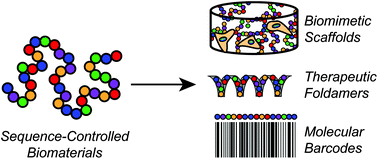
Biomater. Sci., 2019,7, 490-505
https://doi.org/10.1039/C8BM01215F
Acellular biomaterial strategies for endodontic regeneration
This review highlights the evolution of regenerative dental materials with a focus on acellular biomaterials for endodontic treatment.
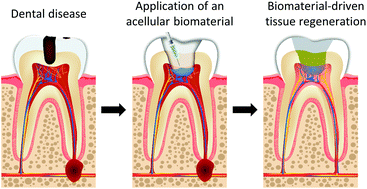
Biomater. Sci., 2019,7, 506-519
https://doi.org/10.1039/C8BM01296B
Engineering a stable future for DNA-origami as a biomaterial
Reviewing the various methods and effectivity to stabilize DNA origami in biological environments.

Biomater. Sci., 2019,7, 532-541
https://doi.org/10.1039/C8BM01249K
Controlled synthesis and assembly of ultra-small nanoclusters for biomedical applications
This Minireview summarizes recent advances in the controlled synthesis, assembly, and biomedical applications of ultra-small nanoclusters.

Biomater. Sci., 2019,7, 480-489
https://doi.org/10.1039/C8BM01200H
Nanomaterials for photoacoustic imaging in the second near-infrared window
The use of nanomaterials as contrast agents for photoacoustic imaging in the NIR-II window enables enhanced imaging quality with deeper tissue penetration.
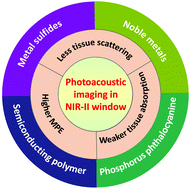
Biomater. Sci., 2019,7, 472-479
https://doi.org/10.1039/C8BM00642C
Calcium phosphate nanocarriers for drug delivery to tumors: imaging, therapy and theranostics
This paper has reviewed the recent advances in the development of CaP nanocarriers and their applications in tumor diagnosis, gene delivery, drug delivery and theranostics and finally discussed the perspectives.

Biomater. Sci., 2019,7, 3942-3960
https://doi.org/10.1039/C9BM00831D
Biomaterials as vectors for the delivery of CRISPR–Cas9
The emergence of the CRISPR–Cas9 gene editing system has generated considerable hope and excitement in the field of gene therapy and the larger scientific community. Recently, biomaterials have become an attractive option for the delivery of Cas9 due to their remarkable versatility.
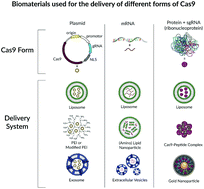
Biomater. Sci., 2019,7, 1240-1261
https://doi.org/10.1039/C8BM01310A
Peptide ligand-mediated targeted drug delivery of nanomedicines
Targeted drug delivery is emerging as a promising strategy to achieve better clinical outcomes.

Biomater. Sci., 2019,7, 461-471
https://doi.org/10.1039/C8BM01340C
Poly(caprolactone-co-trimethylenecarbonate) urethane acrylate resins for digital light processing of bioresorbable tissue engineering implants
Biodegradable polyester urethane acrylate oligomers were created to address the scarcity of resins for Digital Light Processing (DLP). Cell adhesion was heavily influenced by copolymer composition.

Biomater. Sci., 2019,7, 4984-4989
https://doi.org/10.1039/C9BM01042D
Logical stimuli-triggered delivery of small molecules from hydrogel biomaterials
Triggered release of small molecule model therapeutics from hydrogel biomaterials is governed by user-programmable Boolean logic.
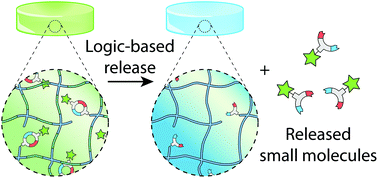
Biomater. Sci., 2019,7, 542-546
https://doi.org/10.1039/C8BM01304G
Glucosamine sulphate-loaded distearoyl phosphocholine liposomes for osteoarthritis treatment: combination of sustained drug release and improved lubrication
A drug-loaded nanocarrier integrating the sustained drug release and improved lubrication ability is fabricated for the treatment of osteoarthritis.

Biomater. Sci., 2019,7, 2716-2728
https://doi.org/10.1039/C9BM00201D
Modulating bioactivities of primary ammonium-tagged antimicrobial aliphatic polycarbonates by varying length, sequence and hydrophobic side chain structure
A highly antimicrobial, biocompatible, and fast biodegradable polycarbonate has been developed by incorporating primary ammonium and monoether side chains.

Biomater. Sci., 2019,7, 2288-2296
https://doi.org/10.1039/C9BM00440H
Spatiotemporal control and modeling of morphogen delivery to induce gradient patterning of stem cell differentiation using fluidic channels
Perfusion of channels embedded in large hydrogels creates opposing morphogen gradients, resulting in multi-differentiation of stem cells into a spectrum of cell fates.
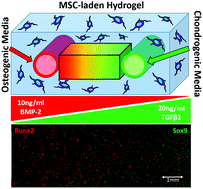
Biomater. Sci., 2019,7, 1358-1371
https://doi.org/10.1039/C8BM01199K
Redox-responsive interleukin-2 nanogel specifically and safely promotes the proliferation and memory precursor differentiation of tumor-reactive T-cells
Interleukin-2 (IL-2) is a potent T-cell mitogen that can adjuvant anti-cancer adoptive T-cell transfer (ACT) immunotherapy by promoting T-cell engraftment.

Biomater. Sci., 2019,7, 1345-1357
https://doi.org/10.1039/C8BM01556B
Conductive elastomer composites for fully polymeric, flexible bioelectronics
Soft, flexible and stretchable conductive elastomers made of polyurethane and PEDOT:PSS blends were fabricated into fully polymeric implantable bioelectrode arrays.
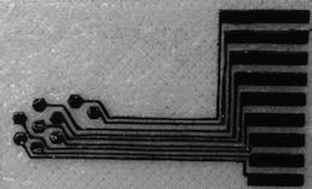
Biomater. Sci., 2019,7, 1372-1385
https://doi.org/10.1039/C8BM01235K
Enhanced local cancer therapy using a CA4P and CDDP co-loaded polypeptide gel depot
A CA4P and CDDP co-loaded polypeptide gel depot was prepared for enhanced local colon cancer treatment.
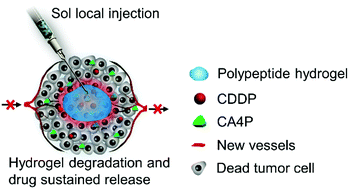
Biomater. Sci., 2019,7, 860-866
https://doi.org/10.1039/C8BM01442F
Universal nanothin silk coatings via controlled spidroin self-assembly
Biomimetic spidroin self-assembly allows formation of substrate-independent one-pot nanothin silk coatings.

Biomater. Sci., 2019,7, 683-695
https://doi.org/10.1039/C8BM01186A
Platelet-like particles dynamically stiffen fibrin matrices and improve wound healing outcomes
PLPs increase fibrin stiffness, promote cell migration, and improve healing outcomes.

Biomater. Sci., 2019,7, 669-682
https://doi.org/10.1039/C8BM01201F
Adipose-derived stem cell-secreted factors promote early stage follicle development in a biomimetic matrix
ADSCs encapsulated in biomimetic PEG hydrogels maintain stemness and secrete survival- and growth-promoting factors that support in vitro folliculogenesis.
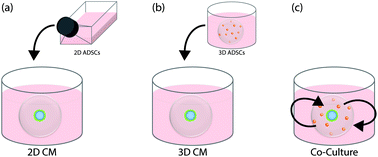
Biomater. Sci., 2019,7, 571-580
https://doi.org/10.1039/C8BM01253A
Celastrol-loaded PEG-b-PPS nanocarriers as an anti-inflammatory treatment for atherosclerosis
Encapsulation within poly(ethylene glycol)-b-poly(propylene sulfide) micelles reduces the toxicity of celastrol and enhances its anti-inflammatory effect during treatment of atherosclerosis.
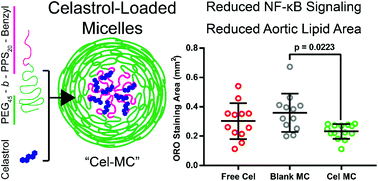
Biomater. Sci., 2019,7, 657-668
https://doi.org/10.1039/C8BM01224E
Macromolecular crowding tunes 3D collagen architecture and cell morphogenesis
Macromolecular crowding of collagen I during polymerization produces short, degradation-resistant fibrils that induce collective morphogenesis of breast cancer cells.

Biomater. Sci., 2019,7, 618-633
https://doi.org/10.1039/C8BM01188E
Polyester-based ink platform with tunable bioactivity for 3D printing of tissue engineering scaffolds
A novel polymeric biomaterial platform with tunable functionalizability for extrusion-based 3D printing.

Biomater. Sci., 2019,7, 560-570
https://doi.org/10.1039/C8BM01269E
Characterizing the encapsulation and release of lentivectors and adeno-associated vectors from degradable alginate hydrogels
In this study, we compare the ability of two different degradable alginate hydrogel formulations to efficiently deliver LV and AAV. We propose that release rates of viral vectors are dependent on the physical properties of both the hydrogels and vectors.
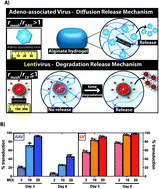
Biomater. Sci., 2019,7, 645-656
https://doi.org/10.1039/C8BM01218K
Fabrication of redox-responsive doxorubicin and paclitaxel prodrug nanoparticles with microfluidics for selective cancer therapy
Doxorubicin–paclitaxel prodrug nanoparticles with redox-responsive were synthesized to selectively inhibit cancer cells with reduced adverse drug effect to healthy cells.
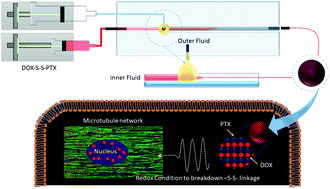
Biomater. Sci., 2019,7, 634-644
https://doi.org/10.1039/C8BM01333K
Degradable redox-responsive disulfide-based nanogel drug carriers via dithiol oxidation polymerization
Stimuli-responsive nanogels degrade to small molecules in reducing environments to mediate controlled drug release.
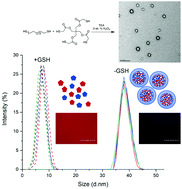
Biomater. Sci., 2019,7, 607-617
https://doi.org/10.1039/C8BM01120F
A pH-responsive hydrogel with potent antibacterial activity against both aerobic and anaerobic pathogens
A pH-responsive hydrogel prepared by oxidized dextran with aminoglycoside and an ornidazole analogue can kill both aerobic and anaerobic pathogens.
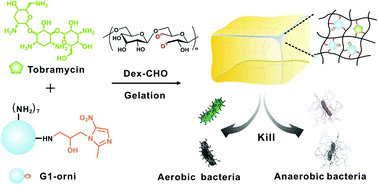
Biomater. Sci., 2019,7, 581-584
https://doi.org/10.1039/C8BM01211C
The influence of electrically conductive and non-conductive nanocomposite scaffolds on the maturation and excitability of engineered cardiac tissues
We developed different classes of hydrogels, with conductive and non-conductive nanomaterials, to study cardiac tissue maturation and excitability.
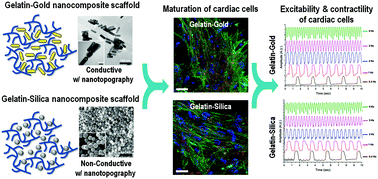
Biomater. Sci., 2019,7, 585-595
https://doi.org/10.1039/C8BM01050A
Delivery of 5′-triphosphate RNA with endosomolytic nanoparticles potently activates RIG-I to improve cancer immunotherapy
Delivery of a 5′ triphosphate RNA (3pRNA), a ligand for RIG-I, with endosomolytic nanoparticles (NP) augments response to anti-PD1 immune checkpoint blockade.
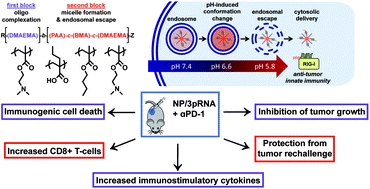
Biomater. Sci., 2019,7, 547-559
https://doi.org/10.1039/C8BM01064A
Intracellular delivery and biodistribution study of CRISPR/Cas9 ribonucleoprotein loaded bioreducible lipidoid nanoparticles
A combinatorial library of cationic lipidoids were used as nanocarriers for intracellular delivery of the CRISPR/Cas9 ribonucleoprotein complex.

Biomater. Sci., 2019,7, 596-606
https://doi.org/10.1039/C8BM00637G
About this collection
Biomaterials Science is proud to present this 2019 Emerging Investigators collection. This collection gathers the very best work from biomaterials scientists in the early stages of their independent careers. The 2019 Biomaterials Science Emerging Investigators were individually nominated by members of the journal Editorial and Advisory Boards, and previous Emerging Investigators, in recognition of their potential to influence future directions in the biomaterials field.
Accompanying this collection is the Emerging Investigators special issue, in which these articles will be formally published. This issue is scheduled for publication in early 2019.